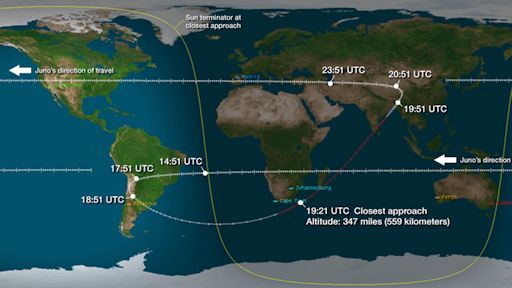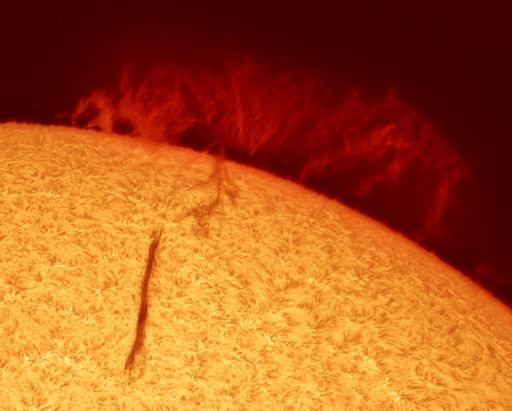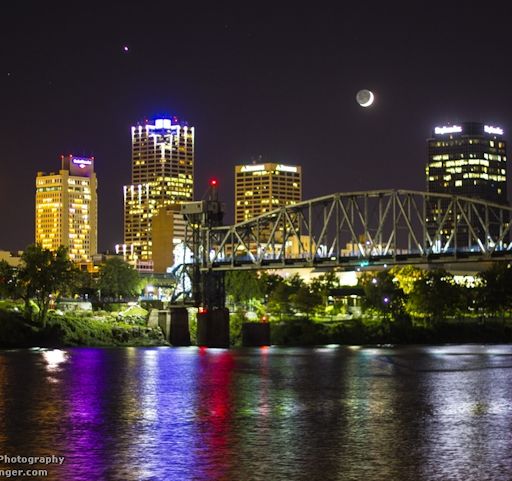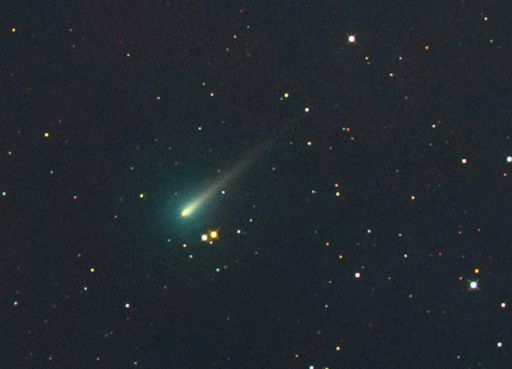CME IMPACT EXPECTED: A minor CME, propelled towarded Earth by a magnetic filament erupting on the sun, could strike our planet's magnetic field during the late hours of Oct. 9th. NOAA forecasters working through the US government shutdown estimate a 30% to 40% chance of polar geomagnetic storms. Aurora alerts: text, voice.
JUNO SPACECRAFT TO FLY BY EARTH: NASA's Juno spacecraft will slingshot past Earth on October 9th for a velocity boost en route to Jupiter. At closest approach the spacecraft will be only 347 miles above Earth's surface. This map shows the spacecraft's ground track:
During the flyby, Juno's science instruments will be activated to sample the Earth environment--a practice run for data-taking when the spacecraft reaches Jupiter in 2016. Despite the shutdown of the US government, "the flyby will continue as planned," says Juno principal investigator Scott Bolton of the Southwest Research Institute. "The commands associated with our instruments were already on board before the shutdown."
To celebrate this event, the Juno team invites amateur radio operators around the world to say "HI" to Juno in a coordinated Morse Code message. Juno's radio and plasma wave experiment, called Waves, should be able to detect the message if enough people participate. Please join in, and help spread the word to fellow amateur radio enthusiasts.
A note about visibility: The spacecraft will not be visible to the unaided eye. Estimates of its maximum brightness range from +7.5 to +8.5. Such a faint object moving rapidly across the sky will be a challenge for even large backyard telescopes. There is a slim chance that sky watchers could see a "Juno flare" if sunlight glints off the spacecraft's large solar arrays. If you want to see a really bright spacecraft, download our Satellite Tracker app and check out the International SPace Station.
GIANT PROMINENCE, GONE: At the end of the day on Oct. 7th, reports of a giant prominence emerging over the sun's northeastern limb began to come in from around the world. "It was huge and easily visible in my Lunt 80mm solar scope," says Paul Haese, who sends this picture from Glenalta, South Australia:
By the morning of Oct. 8th, the prominence was gone. The structure's magnetic underpinnings became unstable and erupted, flinging part of itself into space. NASA's Solar Dynamics Observatory recorded the blast: movie. A coronal mass ejection is now emerging from the blast site, but Earth is not in the line of fire.
Realtime Space Weather Photo Gallery
SUNSET PLANETS: The crescent Moon is gliding by Venus, forming a pretty duo in the sunset sky. Last night, Brian Emfinger photographed the two bright bodies over Little Rock, Arkansas:
"The Moon and Venus provided a excellent backdrop to the Little Rock skyline," says Emfinger.
It's going to happen again tonight. Venus and the Moon are so bright, they pop out of the twilight long before the sunset sky fades to black. If you go out to look, be alert for Earthshine--a ghostly glow illuminating the crescent's dark terrain. Earthshine is sunlight reflected from our own planet onto the Moon. A crescent Moon with Earthshine framed by twilight blue is one of the most beautiful sights in the heavens. Sky maps: Oct. 7, 8.
COMET ISON IN COLOR: Comet ISON is brightening as it approaches the sun. Estimates by experienced observers put the comet between 10th and 11th magnitude. That's too dim to see with the unaided eye, but bright enough for color photography through mid-sized backyard telescopes. Michael Jäger of Weißenkirchen, Austria, observed the comet on Oct. 5th and found that it was green:
To image the comet, Jäger combined multiple exposures through red, green, blue, ultraviolet and infrared filters. Details may be found here.
ISON's green color comes from the gases surrounding its icy nucleus. Jets spewing from the comet's core probably contain cyanogen (CN: a poisonous gas found in many comets) and diatomic carbon (C2). Both substances glow green when illuminated by sunlight in the near-vacuum of space.
Finding Comet ISON is easy. It rises alongside Mars in the eastern sky just before dawn. Amateur astronomers, if you have a GOTO telescope, enter these coordinates. Special dates of interest include Oct. 13-15 when Mars, Comet ISON, and the first magnitude star Regulus will be clustered in a patch of sky less than 3o apart. Red Mars and blue Regulus will form a beautiful naked eye "double star" in the early morning sky. Sky maps: Oct. 8, 9, 10, 11, 12, 13, 14, 15.

Solar wind
speed: 346.9 km/sec
density: 8.8 protons/cm3
explanation | more data
Updated: Today at 1556 UT
X-ray Solar Flares
6-hr max: C1 1511 UT Oct08
24-hr: C1 1511 UT Oct08
explanation | more data
Updated: Today at: 1600 UT
![]()
Daily Sun: 08 Oct 13
None of these sunspots poses a threat for strong flares. Credit: SDO/HMI
![]()
Sunspot number: 76
What is the sunspot number?
Updated 08 Oct 2013
Spotless Days
Current Stretch: 0 days
2013 total: 0 days (0%)
2012 total: 0 days (0%)
2011 total: 2 days (<1%)
2010 total: 51 days (14%)
2009 total: 260 days (71%)
Since 2004: 821 days
Typical Solar Min: 486 days
Update 08 Oct 2013
The Radio Sun
10.7 cm flux: 112 sfu
explanation | more data
Updated 08 Oct 2013
![]()
Current Auroral Oval:
Switch to: Europe, USA, New Zealand, Antarctica
Credit: NOAA/POES
![]()
Planetary K-index
Now: Kp= 1 quiet
24-hr max: Kp= 1 quiet
explanation | more data
Interplanetary Mag. Field
Btotal: 8.3 nT
Bz: 2.6 nT north
explanation | more data
Updated: Today at 1434 UT
![]()
Coronal Holes: 08 Oct 13
Solar wind flowing from this coronal hole should reach Earth on Oct. 10-12. Credit: SDO/AIA.








